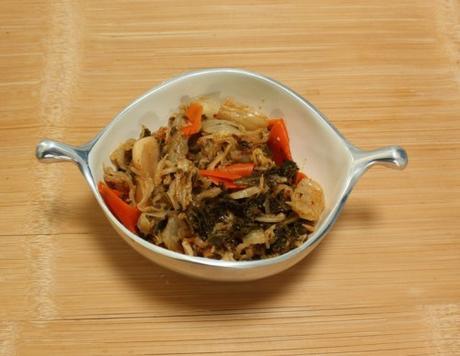 Did you know October 7th is National Kale Day? I didn't either. So it's probably not a surprise that the requisite celebratory dishes are still being established.
Did you know October 7th is National Kale Day? I didn't either. So it's probably not a surprise that the requisite celebratory dishes are still being established.
Kale evangelists are working overtime to remedy this, offering lots of intriguing recipes - tacos and smoothies of course, but also delicacies like Kale Stroganoff, Hoboken Kale Salad and the improbable Kale-onaise. (as yet untested by SpecD).
So is kale kimchi such a stretch? I think not. Someone has to do it.
Kale's dark bitter leaves make for a strongly flavored and scented result, so this kimchi calls for Chinese cabbage to balance it out. This recipe also has a walloping 4 tablespoons of red pepper, a mix of cayenne and Korean gochugaru, to stand up to the kale.
Most traditional Korean recipes start out by salting the cabbage leaves to draw out the juices. My best kimchi results come from massaging and kneading the cabbage and kale, sauerkraut style. All that liquid makes for a thorough ferment and juicy result.
1 lb. kale
1 large head of Chinese cabbage
1 1/2 tablespoons coarse salt
1 bunch or small bag of red radishes
1 bunch scallions
1 large carrot
1 pear
1 head of garlic
1″ piece of ginger
1/4 cup fish sauce
2 tablespoons cayenne pepper
2 tablespoons Korean pepper flakes (gochugaru)
- Wash and dry kale leaves. Trim off the hard center stems: fold the leaf in half along the stem and use a knife or scissors to clip it off. Cut the trimmed leaves into 1″ strips.
- Cut the Chinese cabbage in to 1″ strips.
- Place the kale and cabbage into a large mixing bowl. Sprinkle with the 1 1/2 tablespoons of salt. With clean hands, squeeze and massage and knead the leaves until they are reduced to a wet wilted mass. It takes about 10 minutes in all to get them really broken down. Take a short break if your hands get tired. Check out this video to see how wet you want it to get. Do not drain.
- Prepare the other vegetables: Peel and thinly slice the carrot. Thinly slice the radishes. Cut the scallions into 1″ lengths, then chop to make long slivers. Add these to the kale and cabbage.
- Prepare the pepper paste: Break the head of garlic into cloves and peel them. Peel the ginger root and chop roughly. Core the pear and chop roughly. Add garlic, ginger and pear to the bowl of a food processor with the 1/4 cup fish sauce and puree. Add the cayenne and Korean pepper once the mixture is smooth. (Adding the hot pepper at the end will reduce fumes.)
- WEARING RUBBER GLOVES scrape the paste into the bowl with the vegetables and mix it all together, kneading the paste into the vegetables to fully and evenly disperse it.
- Pack the vegetables into a crock or large jar. Using a spoon or potato masher push the vegetables down so they are submerged in the juices. Use a small saucer or other non-reactive contrivance to keep the vegetables covered. Lay a piece of plastic wrap on top to keep from drying out.
- Set aside in a cool place, out of direct sunlight, to ferment. Choose an out of the way corner; the aroma can be pronounced. Start checking after 5 days. Push down on the vegetables to see if bubbles come out. That's the sign of an active ferment. The longer you let it sit, the stronger and funkier the taste.
- When ready pack into glass jars with close-fitting lids and store in the refrigerator.

